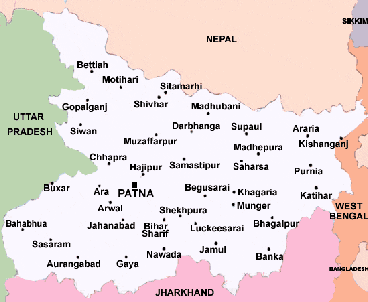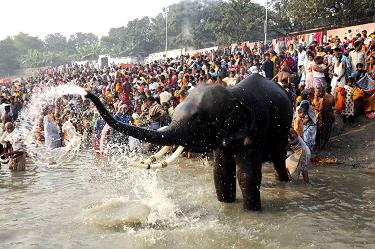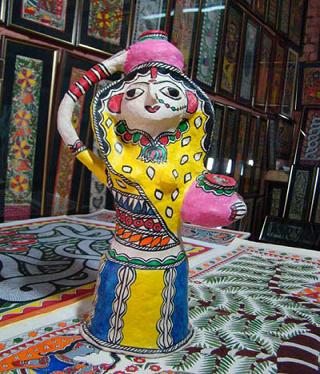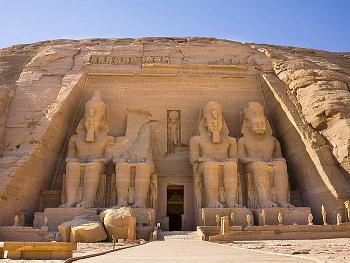
Welcome |
|
|
|
|
|
|
|
|
|
|
|
|
|
|
|
|
|
|
|
|
|
|
|
|
|
|
|
|
|
|
|
|
|
|
|
|
|
|
|
|
|
|
|
|
|
|
|
|
|
|
|
|
|
|
|
|
|
|
|
|
|
|
|
|
|
|
|
|
|
|
|
|
|
|
|
|
|
|
|
|
|
|
|
|
|
|
|
|
Information about
Bihar
|
|
The name Bihar is derived from 'Vihara' or monastery. The state of Bihar is now divided into two parts, namely Jharkhand and Bihar. Jharkhand is inhabited by the
tribes. Patna is the modern capital of Bihar. Bihar is also one of most backward states in India. Bihar is more known as the home of Mahavir and Buddha, where they spent the major part of their life. Some of the most sacred places connected with the life of Buddha are located in Bihar and the neighbouring Uttar Pradesh as Buddha’s travels were confined to these two states. Bihar is also sacred to Buddhists from all over the world who come here for pilgrimage, specially to Bodh Gaya, where the Buddha attained enlightenment. The three major dialects of the people are Maithali prevailing in the east, Magadhi in the south, and Bhojpuri in the west. |
 |
|
|
|
|
History of
Bihar |
|
Bihar was also the state where Buddhism and Jainism, the two great religions of world were born. It was also the state where both the Buddha and Mahavira lived and preached. In ancient times, Bihar witnessed rise and fall of different empires. Different parts of the state at different times in history were parts of Anga, Videh and Vaishali. Bihar was settled from the west as Aryan tribes moved down the Ganga valley, clearing the forest and developing cultivation. Bihar was the core part of the famous empire of Magadha under the Maurya and Gupta dynasties. The antiquity of Magadha can be seen from the Vedas. The kings of Magadha were so mighty that Alexander the Great decided to retreat from India apprehending defeat. In the closing years of the 4th century B.C., Magadha became a greater power under Maurya and his grandson, Chandragupta. They ruled from the south Bihar from the 4th to 6th centuries BC. The early Magadha kings had their capital at Rajgriha, 100 km south east of Patna. Later they moved their capital to Pataliputra, the site of modern Patna. Pataliputra at that time was as important as Rome in subsequent centuries. The Emperor Ashoka, the great Buddhist emperor, ruled over the entire Indian subcontinent from Patliputra, at that time the capital of India and spread the message of Buddha not only in India but also beyond its shores. It was during Ashoka’s time in the third century B.C. that Buddhism spread to the former Soviet Republics and Afghanistan in the west and Thailand, China, Japan and Indonesia in the east. The Guptas played a central role in the flowering of the Hindu culture of the classical period and regained power for Magadha in the 4th and 5th centuries AD. Various Delhi Sultans and Muslim rulers controlled the region until the Mughals brought it into the territory. When Akbar retook it from the Afghan ruler, the Mughals retained it until the British won the Battle of Buxar
in 1764. As a result, Bihar was separated from Bengal and
became a province under the British rule until the India's
independence in 1947. Today, Bihar has become one of the
India's poorest and badly administered state. |
|
|
|
|
Geography of
Bihar |
|
Bihar is a region of transition from the wet lowlands of Bengal to the prosperous plains of west Uttar Pradesh, Haryana and Punjab. The present state of Bihar covers an area of 173,876 square km. and is surrounded by West Bengal, Orissa, Uttar Pradesh, Madhya Pradesh and Nepal. The most important river that flows in Bihar is the Ganga, that flows from the west to the east for 560 km though the heart of the plains which comprises the state's central region. The Ganga is joined by its northern tributaries from the Nepal Himalayas like the Son-Kosi. Torrential rains in the Himalayan foothills and the flatness of the Ganga valley floor causes some of the rivers like Kosi to flood catastrophically. The Kosi river has also dhifted his course frequently and over a period of 130 years has moved over 110 km westwards. The alluvium barely covers the ancient rocks of peninsular India which forms the Chota Nagpur plateau. There is a beautiful open parkland scenery in Chota Nagpur plateau. There are also various hills, lakes and forests in Bihar. Irrigation and hydroelectric works like the Damodar
Valley project have been developed which are slowly changing
the face of Bihar. |
|
|
|
|
Economy of Bihar |
|
Most of the people in Bihar earn their living by cultivating rice. Yet, it possesses huge reserves which are now gradually being exploited. Coal, iron, mica, copper and bauxite constitute about 40% of the mineral wealth of India. These deposits lies on the Chota Nagpur plateau, which now lies in the state of Jharkhand and have been the basis of rapid industrial expansion in towns like Jamshedpur, Ranchi and Dhanbad. Jamshedpur was founded as the location of the India's first integrated iron and steel mill, opened by the Jamshedji Tata in 1908. Since independence, various industrial projects have been undertaken by the government of India like Bokaro steel mill in the Damodar Valley and Bharat Heavy Electricals. |
|
|
|
|
Festivals of Bihar |
|
Some of the festivals which are celebrated in Bihar are Buddha Jayanti, Mahavir Jayanti, Pataliputra Festival, Dussehra, Diwali and Chhath or Surya Puja. Bodh Gaya and Rajgir attracts Buddhists from all over the world and celebrates the Buddha Jayanti, the birth of Lord Buddha. Mahavir Jayanti is celebrated with lot of enthusiasm in Parasnath hill. Dussehra and Diwali are also celebrated in Bihar like other states in India. Chhath or Surya Puja is held after six days of Diwali. This festival is celebrated to worship the Sun God. Fresh paddy, sweets and fruits are offered by the devotees to the Sun God for a good harvest.
|
 |
|
|
|
|
Cuisine of Bihar |
|
Bihar doesn't have a distinctive style of cooking. The typical meal consists of the boiled rice, unleavened bread, lentils and vegetables cooked with hot spices. Sattoo which is combination of grains is often made into a dough and eaten either as a savoury or a sweet when mixed with sugar of jaggery. The mixture can also be taken as a drink when mixed with milk or water and flavoured with cardamom and cloves. |
|
|
|
|
Crafts of Bihar |
 |
Bihar is the home of Madhubani painting. This painting originated from Mithila where the women created a striking folk art and draw various mythology figures on the walls and floors of the mud huts using various bright colours with strong lines. They used the red, blue, green, black and yellow colour powder in paintings and mixed it with goats milk and made these paintings on the handmade paper and fabric. They also made various greeting cards and wall hangings showing Krishna with gopis and various other mythological and religious objects. This village wall paintings now adorn the gracious city homes and exported.
However, the ancient designs in bright colors can still be
seen on the mud walls in the districts of Champaran, Saharsa,
Muzaffarpur, Vaishali, Darbhanga, Samastipur, Begusarai,
Purnea, Bhagalpur. The floral 'Alpana' patterns which are painted on the floor with chalk or rice powder have been now transferred to paper, cloth or wood and sold as decorative items. Bihar is also known for the miniature paintings, wooden
toys, small white metal figures, wall hangings, wooden stools,
miniatures in paper and leaves, |
|
stone pottery, bamboo and leather goods and appliqué work. The craftsmen also uses different woods, ivory, metal and horn to create inlaid designs for table tops, trays and wall plaques. |
|
|
|
|
|
Tourist Attractions in Bihar |
|
Bihar attracts Buddhists and Jains from all over the world. Bihar is the home of the Buddha and Mahavira, the founder of Jainism. Patna, Nalanda, Vaishali, Bodh Gaya, Lumbini, Rajgir, Kushinagar, Sravasti, Gaya, Pawapuri, Ranchi and Jamshedpur are the various famous cities in Bihar. Sravasti, Kushinagar, Vaishali, Rajgir, Lumbini and Bodh Gaya are the various places which are of interest to the Buddhists. Nalanda, Gaya and Pawapuri are the various cities which are associated with Mahavira. Jamshedpur is known as the steel city. |
 |
|
|
|
|
Wildlife Sanctuaries in Bihar |
|
There is only one
wildlife sanctuary and tiger reserve in Bihar. This reserve is
the Palamau Tiger Reserve. The Palamau Tiger Reserve is
situated along the northern edge of the Chota Nagpur Plateau.
This reserve covers an area of 1026 square km. The undulating
terrain is set off by sal forests and thickets of bamboo. The
Koel River and its tributaries runs through the reserve. Some
of the animals like tiger, leopard, elephant, gaur, sambar,
muntjac, Indian wolf and nilgai are found in the Palamau Tiger
reserve. The best time to visit the Palamau Tiger Reserve is
throughout the year. The nearest airport is situated at Ranchi,
about 180 kms. and the railway station is located at
Daltonganj, about 25 kms. away from the reserve. |
|
|